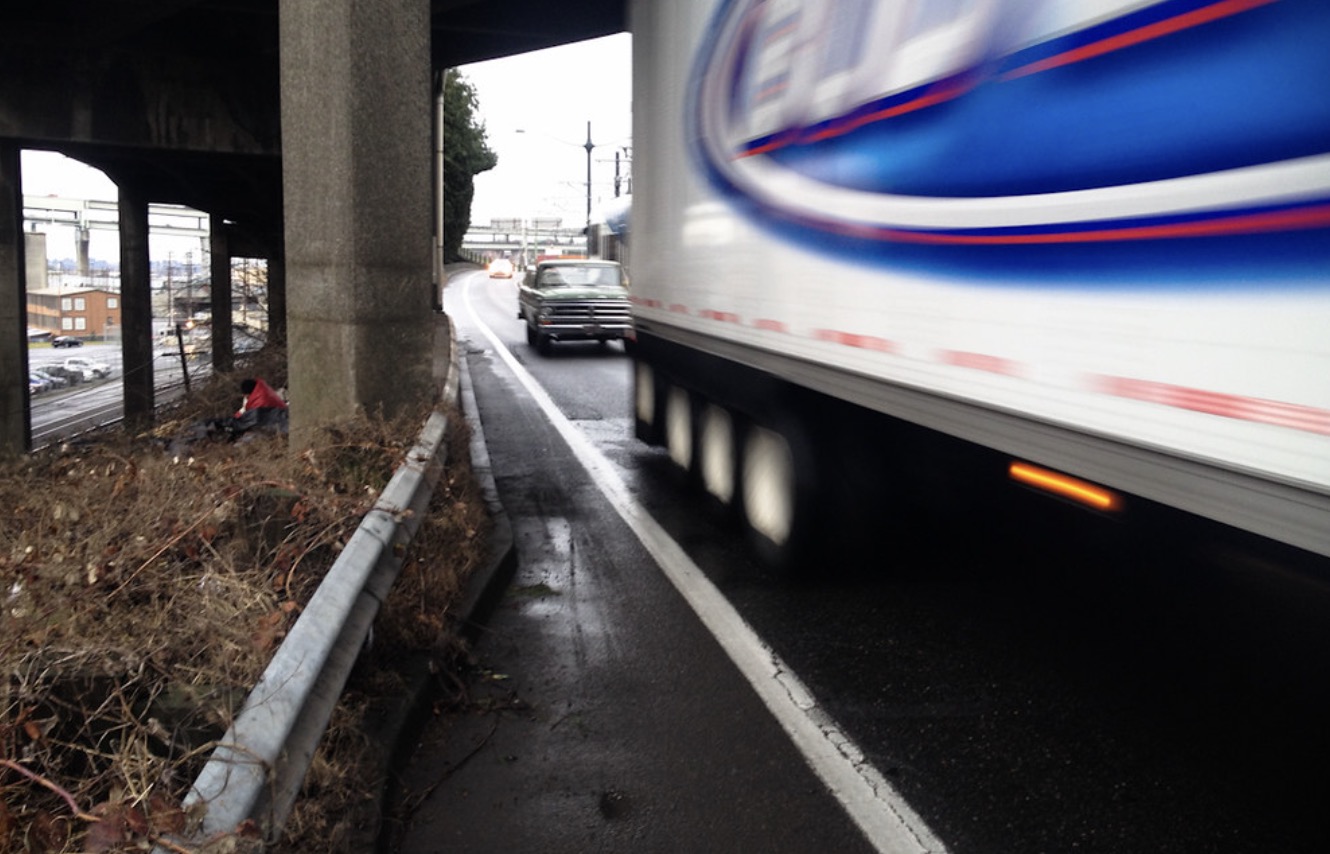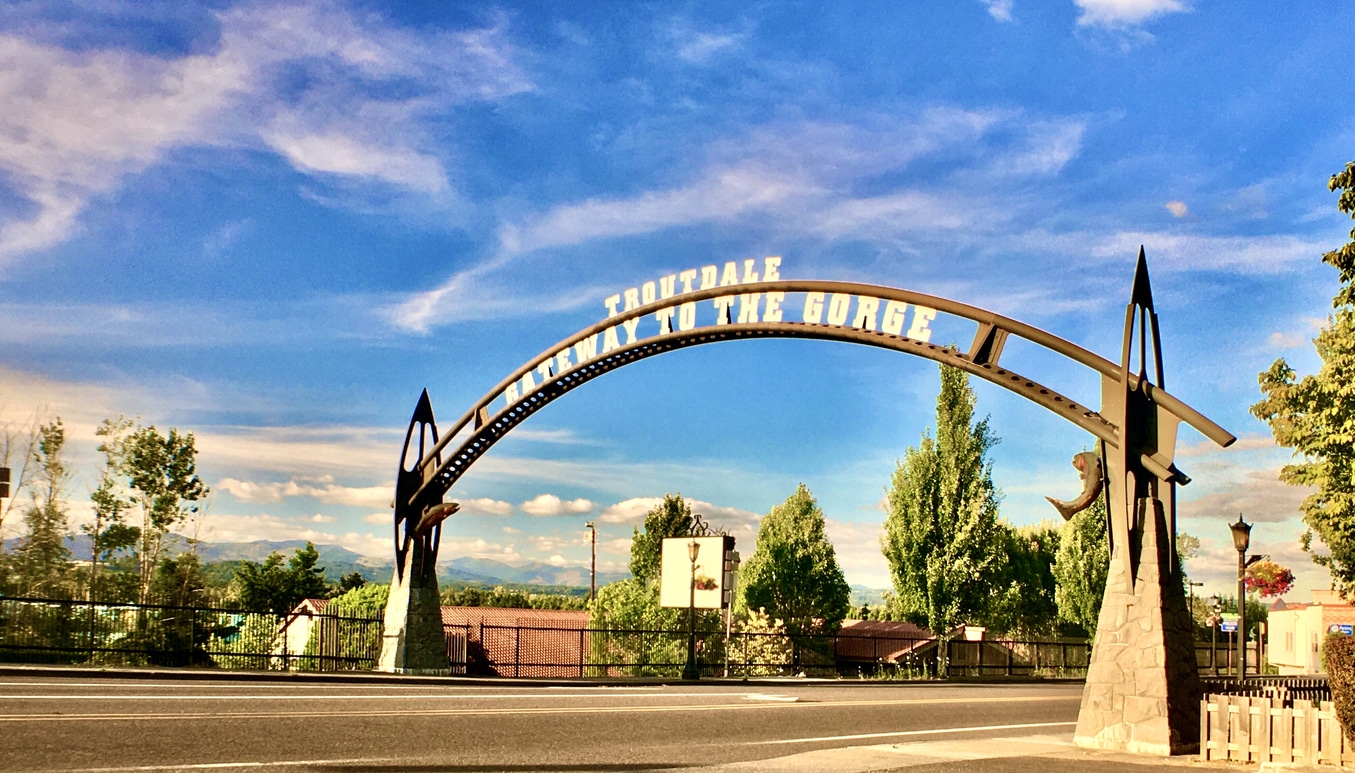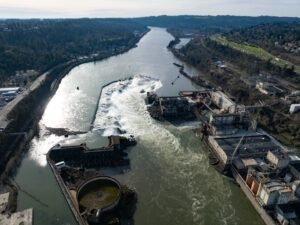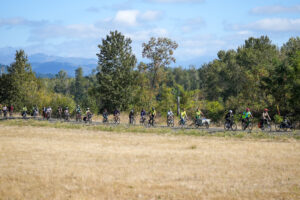Trucking advocates face headwinds in push for mandatory 12-foot lanes – BikePortland

The trucking industry wants more room on Oregon roads and they’ve taken an unprecedented step to get it. Instead of working through traditional project development channels where engineers, planners and advocates work together to solve design issues based on compromise and context on a project-by-project basis, trucking advocates are pushing a mandatory 12-foot minimum lane width on freight routes statewide.
On the last page of the 102-page House Bill 2025 (the transportation bill) being debated in Salem this week are three lines that could have major implications on projects across the state. Section 160 of the bill states: “the commission may not reduce the width of an existing motor vehicle travel lane on an identified freight route to less than 12 feet.” (The “commission” refers to the Oregon Transportation Commission, a governor-appointed body that oversees the Oregon Department of Transportation.)
Trucking advocates are making a rare and bold attempt to circumvent process and enshrine what should be a transportation engineering decision into state law. Beyond that, the vague language of “identified freight route” could leave the question of which roads this applies to open to discretion. For those reasons and others, the trucking industry’s latest gambit to make headway on this issue faces strong opposition from road safety advocates. It’s also not supported by state and national design guidelines or best practices, and even Oregon’s chief traffic engineer seems to prefer a different approach.
The provision is backed by trucking advocates like Jana Jarvis, president of the Oregon Trucking Association (OTA). In testimony at the public hearing on HB 2025 Tuesday, Jarvis said the lane width language is an, “important piece of the legislation.” “Freight routes need to be built and maintained to support large trucks by requiring 12-foot lanes to safely accommodate those vehicles,” she testified.
Pushing for wider lanes has been a major focus of trucking advocates for years. In 2022 BikePortland detailed growing tensions between trucking companies and ODOT staff over lane widths. The issue became such a common debate among trucking representatives and ODOT project staff at freight project advisory committee meetings that the agency formed the Travel Lane Widths Work Group in March 2023.
In January 2024, OTA Government Relations Policy Advisor Mark Gibson said truck drivers need a minimum of 12 feet because “there’s a great deal of stress being a truck driver in an urban environment.” In a presentation to the ODOT Mobility Advisory Committee (the MAC, where decisions about freight route lane widths are made) Gibson said, “We’re all suffering from the road diet era.”
Contrast that perspective of a truck driver with the people outside the truck. Walkers, bicycle riders, motorcycle users — even smaller car drivers who use roads alongside truckers feel the impacts of wider lanes. Wider lanes lead to higher speeds, longer crossing distances, and more risk for road users overall. And road widths are finite: When you add a foot to one lane, it means another lane must become narrower. When that lane is a bike lane or shoulder, other road users suffers.
That’s one reason the 12-foot lane provision has drawn opposition from transportation advocates like David Binnig with BikeLoud PDX. In a letter submitted to the Joint Committee on Transportation Reinvestment, Binnig requested that the language be removed from the bill. He wrote, “While 12-foot lanes may be appropriate on high-speed freeways, they are not suitable on streets where people live and work.”
Binning pointed out that the provision works against the legislature’s intention to boost funding in HB 2025 for ODOT’s Great Streets program — a program that seeks to update urban highways and transform them from traffic and freight thoroughfares into more humane and livable streets where commerce and community can thrive.
If the lane width provision remains in the bill, Binnig wrote, “Oregon would be dedicating funding to safer streets while at the same time outlawing the changes on the ground that are needed to make those streets safe.”
Trucking advocates point to the fact that a typical freight truck is 10 and-a-half feet wide (including side-mirrors) and 12-foot lanes are necessary so drivers don’t have to encroach into adjacent lanes (or bike lane buffers). But best practices in the planning and engineering field say 11-foot lanes are preferable because 12-foot lanes are not worth the safety tradeoffs.
ODOT’s own Highway Design Manual extols the safety virtues of narrow lane widths and clearly states that 11-foot lanes are preferred. In fact, ODOT Chief Engineer Mike Kimlinger doesn’t even appear to support such a rigid adherence to 12-foot lanes for freight.
In a December 2024 meeting of the Mobility Advisory Committee, ODOT staff presented on a project on Highway 26 through downtown Madras where they wanted to increase the width of the bike lane. Trucking advocates aired concerns and a spirited debate ensued.
Gibson from the OTA and another MAC committee member, Highway Heavy Hauling President Kristine Kennedy, wanted to narrow the bike lane in order to give truck drivers more room.
But ODOT’s Kimlinger pushed back. According to MAC meeting minutes, he opposed the OTA’s insistence on 12-foot lanes. “The desire in narrowing the lanes is truly to focus everybody, slow them all down, and make them be very attentive,” reads a paraphrased version of Kimlinger’s response captured by the committee secretary. Kimlinger then went on to point out how five-foot bike lanes would be too narrow and wouldn’t be used because riders wouldn’t feel comfortable in them. Here’s another excerpt from the minutes:
“[Kimlinger] ended by saying, yes, 11 [feet] is narrow and is going to be a bit uncomfortable for the 12-foot loads of equipment that come through, but when we are the main street of a community like this, we are put in a position to help balance that in a way we have never done before in our past.”
With negative safety implications, a divergence from best practices, opposition from transportation safety advocates, and a lack of support from ODOT’s own chief engineer, the chances of Section 160 staying in the bill appear to be getting narrower by the day.
Share this content:















Post Comment